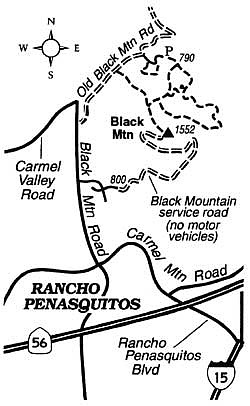 Facebook
Facebook
 X
X
 Instagram
Instagram
 TikTok
TikTok
 Youtube
Youtube
Black Mountain's triangular profile is a familiar sight to residents of Rancho Peñasquitos, Mira Mesa, Sabre Springs, Carmel Mountain Ranch, and Rancho Bernardo. The cluster of microwave antennas at its apex testifies to the mountain's importance in line-of-sight electronic communication and suggests how inclusive a view you can get from the summit area on a clear day.
Several hiking routes converge on Black Mountain's summit. A short but somewhat arduous hike up the mountain's brushy north flank starts at San Diego's Black Mountain Open-Space Park along the unpaved Old Black Mountain Road, about three miles north of Carmel Mountain Road, in Rancho Peñasquitos. That entrance has been hard to find during the ongoing construction of Carmel Valley Road, east of Black Mountain Road, for the past two years.
A more straightforward, if somewhat less interesting approach, starts on the mountain's west side. Follow Stargaze Avenue east from Black Mountain Road (at a point a mile north of Carmel Mountain Road); turn left at Laurentian Drive; continue a couple of blocks to a dead end; and park on the street. Walk beyond the vehicle gate and up along Black Mountain's gradually ascending service road, past low-growing sage scrub and chaparral vegetation, gaining 750 feet of elevation in about 1.7 miles.

Even though you can't enjoy a full 360-degree view from the summit in a single stance, all you have to do is walk halfway around the fenced antenna structures to get the whole picture. The unique perspective afforded by Black Mountain tells a lot about San Diego's topography. To the south, overlain by seemingly endless rooftops, is a mesa-like platform called the Linda Vista Terrace. This is actually the middle level of three successive marine terraces evident in the region. A few remnants of the oldest and highest terrace, the Poway Terrace, can be glimpsed in the southeast and east. Imagine how this landscape looked sometime in the Pleistocene Epoch (a million or so years ago), with ocean waves rolling in over today's Rancho Peñasquitos, Mira Mesa, and Kearny Mesa and breakers crashing against a shoreline somewhere east of Interstate 15.
Farther afield, if the day is transparent enough, you may spot Mexico's Islas de los Coronados poking up sharply beyond Point Loma to the south, San Clemente and Santa Catalina Islands floating like mirages on the watery west horizon, and even Old Baldy poking up on the crest of the San Gabriel

Black Mountain's triangular profile is a familiar sight to residents of Rancho Peñasquitos, Mira Mesa, Sabre Springs, Carmel Mountain Ranch, and Rancho Bernardo. The cluster of microwave antennas at its apex testifies to the mountain's importance in line-of-sight electronic communication and suggests how inclusive a view you can get from the summit area on a clear day.
Several hiking routes converge on Black Mountain's summit. A short but somewhat arduous hike up the mountain's brushy north flank starts at San Diego's Black Mountain Open-Space Park along the unpaved Old Black Mountain Road, about three miles north of Carmel Mountain Road, in Rancho Peñasquitos. That entrance has been hard to find during the ongoing construction of Carmel Valley Road, east of Black Mountain Road, for the past two years.
A more straightforward, if somewhat less interesting approach, starts on the mountain's west side. Follow Stargaze Avenue east from Black Mountain Road (at a point a mile north of Carmel Mountain Road); turn left at Laurentian Drive; continue a couple of blocks to a dead end; and park on the street. Walk beyond the vehicle gate and up along Black Mountain's gradually ascending service road, past low-growing sage scrub and chaparral vegetation, gaining 750 feet of elevation in about 1.7 miles.

Even though you can't enjoy a full 360-degree view from the summit in a single stance, all you have to do is walk halfway around the fenced antenna structures to get the whole picture. The unique perspective afforded by Black Mountain tells a lot about San Diego's topography. To the south, overlain by seemingly endless rooftops, is a mesa-like platform called the Linda Vista Terrace. This is actually the middle level of three successive marine terraces evident in the region. A few remnants of the oldest and highest terrace, the Poway Terrace, can be glimpsed in the southeast and east. Imagine how this landscape looked sometime in the Pleistocene Epoch (a million or so years ago), with ocean waves rolling in over today's Rancho Peñasquitos, Mira Mesa, and Kearny Mesa and breakers crashing against a shoreline somewhere east of Interstate 15.
Farther afield, if the day is transparent enough, you may spot Mexico's Islas de los Coronados poking up sharply beyond Point Loma to the south, San Clemente and Santa Catalina Islands floating like mirages on the watery west horizon, and even Old Baldy poking up on the crest of the San Gabriel
Comments